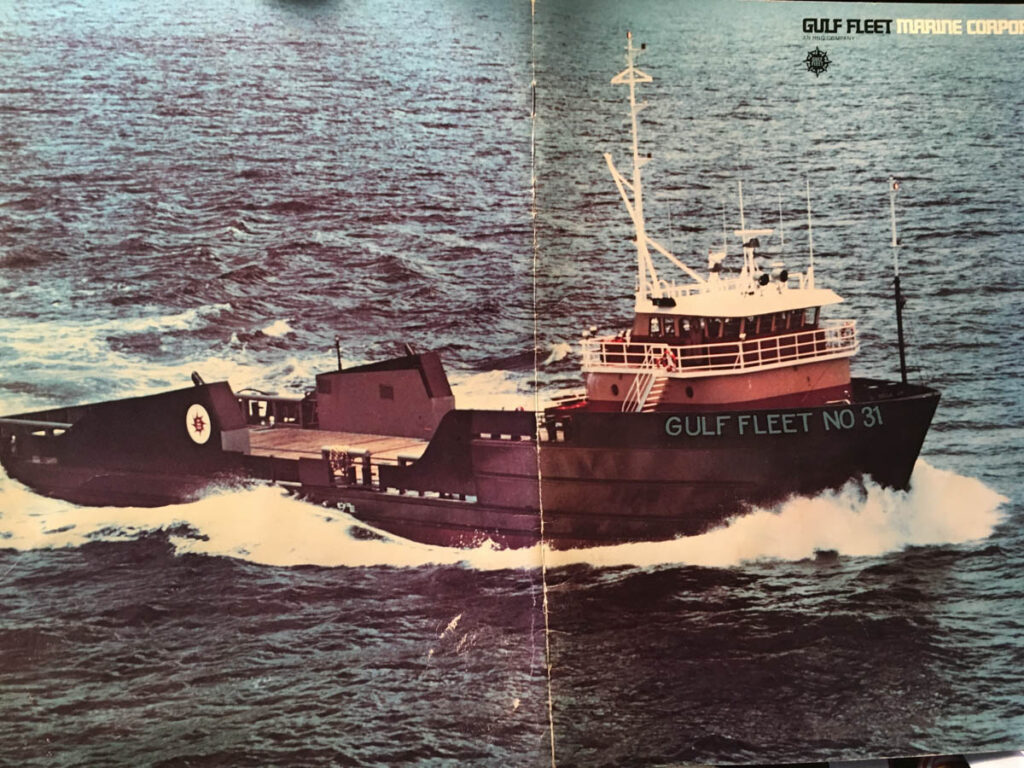A Sunken Legacy of Gulf Marine Exploration
In the heart of the Gulf of Mexico, where offshore supply vessels are the unsung heroes of the oil industry, a remarkable vessel known as Gulf Fleet No. 31 emerged from the shipyards of Houma, Louisiana in 1978. This formidable offshore supply vessel, with its striking statistics and an enigmatic history, has left a lasting mark on the maritime world.
Setting Sail
With a history deeply intertwined with the bustling maritime industry, Gulf Fleet No. 31 was born in the renowned Quality Equipment Co. shipyard. At 294 Gross Registered Tons (GRT), this vessel was a product of ingenuity, designed to cater to the demanding needs of the Gulf Fleet Marine Company, headquartered in Lafayette, Louisiana. As she gracefully kissed the water for the first time in 1978, Gulf Fleet No. 31 boasted impressive dimensions: a length of 54.9 meters, a beam of 11.6 meters, and a draft of 4.18 meters. Her twin diesels and powerful shafts allowed her to slice through the waves at a brisk 12 knots.
The Ownership Mystery
There’s a whisper of uncertainty surrounding the vessel’s ownership. Some sources suggest that Gulf Fleet No. 31 was under the command of the Zapata Gulf Marine Company, rather than the Gulf Fleet Marine. However, a closer look reveals that this mystery may simply be a misunderstanding. The vessel’s name, Gulf Fleet, and the shipyard where she was meticulously crafted, Quality Shipyard, both belonged to Tidewater Inc., headquartered in New Orleans, Louisiana. Tidewater Inc. has been a steadfast pillar of Quality Shipyard, cementing its status as the true owner of Gulf Fleet No. 31.
The Gulf Fleet No. 31 Legacy
Gulf Fleet Marine, whether through acquisition or construction, added a fleet of 77 vessels between 1971 and 1984, all bearing the title “Gulf Fleet No.” followed by a sequential number. This impressive collection of maritime workhorses was instrumental in supporting offshore oil rigs in the Gulf of Mexico.
The vessel’s design, still prevalent in modern offshore supply vessels, is attributed to the visionary Mr. Alden J. ‘Doc’ Laborde, then the president of Ocean Drilling and Exploration Corporation (ODECO) in the late 1940s. Recognizing the need for purpose-built support vessels, Laborde and nine like-minded investors laid the foundation for Tidewater Marine Service Corporation in July 1954. This design, characterized by a forward pilothouse and accommodations and a flat work area at the rear, has stood the test of time as the optimal configuration for supplying offshore work sites.
The Zapata Connection
Notably, the Zapata Corporation, founded by the esteemed former U.S. President George Bush Sr. in 1953, once held the reins of Zapata Gulf Marine until its acquisition by Tidewater Inc. in 1993, marking a significant moment in maritime history.
The Mysterious Demise
Intrigue shrouds the loss of Gulf Fleet No. 31. While the Miramar Index suggests the ship’s disappearance occurred in September of 1985, there’s been ongoing debate since the vessel was rediscovered in 1995. It is now believed that the ship struck the northeast tip of Shaabruhr Umm Qammar, leading the crew to abandon ship. Gulf Fleet No. 31 remained precariously perched on the reef for a few weeks before sliding into its final resting place. Remarkably, no lives were lost during the grounding or subsequent sinking.
Diving Into History
For technical divers with a thirst for adventure, Gulf Fleet No. 31 offers a unique challenge in the depths of the Red Sea. This incredible wreck, sitting upright on a rocky outcrop near the northeast tip of Sha’abruhr Umm Qammar Reef, beckons exploration. With a maximum depth of 108 meters, divers can spot the stern at 105 meters, complete with rudders and propellers. Further up, at 95 meters, lies the opportunity for penetration, providing access to the pilothouse. Towards the aft, two cargo containers, likely the crew’s sleeping quarters, await at 86 meters. Don’t forget to check out the cranes on the open work deck. The aquatic life is flourishing, boasting soft corals, fusiliers, and a variety of other fish.
Ascending along the reef wall for decompression stops, divers may opt to drift in the southern current for a glimpse of the Colona IV at the deepest deco stop around 64-66 meters. However, this exhilarating dive, like all technical dives, demands meticulous planning and robust surface support.
Gulf Fleet No. 31 is a vessel whose legacy continues to intrigue, both in the annals of maritime history and as a unique diving opportunity for those seeking to uncover its enigmatic past.







